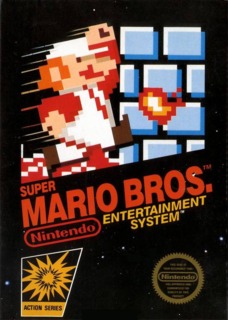In celebration of Super Mario Bros.' 25th anniversary, a review...
Super Mario Bros. is a platform game that had set the standards for today's platformers. The platforming sub-genre of action games pretty much started with Activision's Pitfall! SMB, however, was the real deal; there is much more depth to be experienced and more enticing game mechanics.
Of course, I am reviewing the Game Boy Advance version of the game, but it's extremely identical to the NES version, so I'm not going to compare.
Obviously, there is a story attached to the game; there was a peaceful land named the Mushroom Kingdom, ruled by Princess Toadstool (present day Princess Peach) and a community of toadstools (commonly named "Toad" for short). A dark day occurred when a tribe of turtles known as the Koopa started to invade the Kingdom and captured the Princess's seven servants. Peach had some sort of power that can stop the Koopa disaster, but their leader, Bowser, kidnaps her to prevent any damage to his evil plans. Along came Mario and his brother Luigi, who were determined to put an end to the takeover.
Your objective is to travel the Mushroom Kingdom to rescue the seven Toad servants (made optional by the game's hidden secrets, but I won't spoil it) and the Princess from Bowser's clutches. There are many elements to the game. There are blocks to jump under and hit to break them, or reveal power ups that give you an advantage. Red mushrooms make Mario larger and help him survive a hit instead of dying. Fire Flowers, which appear in place of red mushrooms and only appear when you are affected with the red mushroom, allows Mario to toss fireballs at most enemies until he is hit. The rare green mushroom gives Mario an extra live, helping you stay in the game longer. The Starman makes Mario temporarily invincible, while killing every enemy he runs over.
There is also a new element called coins that make the game more innovative. Coins are scattered everywhere in the game, even in blocks. If you're lucky, some blocks even contain multiple coins that give you one every time you hit the block. Earning one hundred coins give you an extra life.
The controls for the game were pretty decent, but in later games, it improved upon them. Simply pressing left or right on the control pad moves Mario in that direction. The A button makes Mario jump over gaps, up higher platforms, stomp on enemies, and hit blocks. Holding the B button makes Mario run faster, but pressing in also throws fireballs while under the influence of the Fire Flower. As a first traditional platformer, the controls are quite difficult to get used to, as it's hard to steer your character sharply, but for its time, it's acceptable.
The music and sound in this game is awesome, and I mean REALLY awesome. Who would reject the excellent and catchy tunes and the sounds of coins being collected? If you don't agree with me, you have issues.
Graphically, the game lacks much color. Most of the time, you would be seeing a lot of brown color, and perhaps a lot of gray in the game's fortress stages, but for an early NES game, it's excusable.
This concludes my short review of one of the best games ever conceived by man. My recommendation is that you buy this game for the Wii Virtual Console; it's an amazing platforming experience that fixed Atari's mistakes and helped revive the almost fallen industry.

